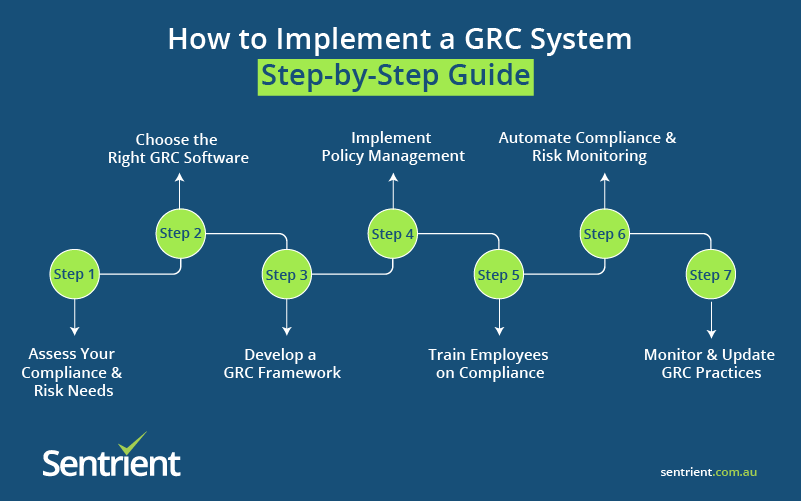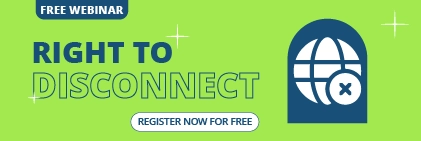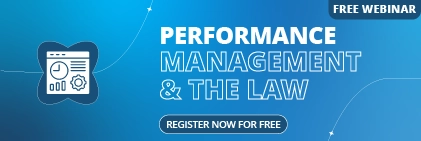In today’s complex regulatory environment, businesses face increasing pressure to maintain compliance while effectively managing risks. A Governance, Risk, and Compliance (GRC) system offers a structured approach to these challenges, helping organisations automate operations and avoid costly penalties.
But how exactly do you implement a GRC system in your business? This comprehensive guide walks you through the process step by step, ensuring you can establish an effective compliance framework regardless of your company’s size or industry.
What is a GRC System?
A GRC system integrates three critical business functions:
- Governance: The framework of rules, practices, and processes that direct and control your organization.
- Risk Management: Identifying, assessing, and mitigating potential risks to your business.
- Compliance: Ensuring your organization adheres to relevant laws, regulations, and internal policies.
While a GRC framework refers to the general strategy and methodology, a GRC platform is the software solution that enables you to implement and manage this framework efficiently.
The best GRC systems combine both elements, providing a comprehensive approach to managing your business’s governance, risk, and compliance requirements.
Why Your Business Needs a GRC System
Australian and New Zealand businesses operate in an increasingly regulated environment. Here’s why implementing a GRC system is important in Australia and New Zealand.
1. Regulatory Compliance
From the Fair Work Act/Employment Relations Act to industry-specific regulations, businesses must manage a complex web of compliance requirements. That’s where a GRC system helps you:
- Track regulatory changes affecting your business
- Implement necessary policy updates
- Document compliance efforts for regulatory inspections
- Manage privacy compliance under the Privacy Act
2. Risk Reduction
Every business faces risks – from cybersecurity threats to workplace safety issues. A GRC system enables:
- Systematic identification of potential risks
- Assessment of risk likelihood and impact
- Implementation of controls to mitigate risks
- Regular monitoring of risk management effectiveness
3. Improved Audit Preparedness
When auditors come knocking, a GRC system ensures you’re ready because there are:
- Centralised documentation of policies and procedures
- Evidence of compliance training completion
- Records of incident management and resolution
- Automated reporting capabilities for quick information retrieval
How to Implement a GRC System: Step-by-Step Guide
Implementing a GRC system requires careful planning and execution. Follow these steps to ensure a successful GRC system implementation.
Step 1: Assess Your Compliance and Risk Needs
Before selecting a GRC solution, thoroughly understand your organisation’s specific requirements:
- Identify industry-specific regulations relevant to your business (i.e: financial services, healthcare, education, etc.)
- Conduct a risk assessment to identify your most significant risk areas
- Review current compliance processes to identify gaps and inefficiencies
- Determine key stakeholders who need access to the GRC system
This assessment forms the foundation of your GRC implementation strategy, ensuring you select a solution that addresses your unique needs.
Step 2: Choose the Right GRC Software
With a clear understanding of your requirements, you can evaluate GRC software options:
- Cloud-based vs. on-premises solutions: Cloud-based options like Sentrient offer greater accessibility, automatic updates, and typically lower upfront costs
- Scalability: Ensure the solution can grow with your business
- Integration capabilities: The GRC system should work seamlessly with your existing tools
- Customisation options: Different industries have unique compliance requirements
Step 3: Develop a GRC Framework
Once you’ve selected your GRC software, establish a framework that defines:
- Governance structure: Who is responsible for what aspects of GRC
- Risk appetite: The level of risk your organisation is willing to accept
- Compliance priorities: Which regulations and policies are most critical
- Reporting requirements: How GRC information will be communicated to stakeholders
This framework should align with your company’s overall objectives and existing policies while addressing your compliance goals.
Step 4: Implement Policy Management
Effective policy management is central to GRC implementation:
- Centralise all policies in your GRC system for easy access
- Automate policy distribution to relevant employees
- Track acknowledgments to ensure policies are read and understood
- Establish review cycles to keep policies current with regulatory changes
A GRC system’s policy management module allows you to upload existing policies or use legally endorsed templates designed for businesses.
Step 5: Train Employees on Compliance
Even the best GRC system won’t be effective without proper training:
- Provide role-based compliance training targeting each employee’s specific responsibilities
- Conduct regular refresher courses to reinforce knowledge
- Use engaging, interactive formats to improve retention
- Track completion rates to ensure all employees meet training requirements
Sentrient offers a comprehensive library of online compliance training modules covering everything from workplace health and safety to anti-discrimination laws, all tailored to Australian and New Zealand regulations.
Step 6: Automate Compliance and Risk Monitoring
- Leverage your GRC software’s automation capabilities:
- Set up automated alerts for compliance deadlines
- Implement real-time risk monitoring to identify emerging issues
- Create automated workflows for incident reporting and investigation
- Establish dashboard monitoring of key compliance metrics
Automation reduces the administrative burden of compliance management while ensuring nothing falls through the cracks.
Step 7: Monitor & Update GRC Practices
GRC implementation isn’t a one-time project but an ongoing process:
- Conduct regular internal audits to test control effectiveness
- Update policies and procedures as regulations evolve
- Gather user feedback to improve system usability
- Review and refine risk assessments based on changing business conditions
Regular monitoring ensures your GRC system continues to meet your needs and address emerging risks and regulatory changes.
Common Challenges in Implementing a GRC System
While implementing a GRC system brings significant benefits, organisations often face several challenges during the process:
1. High Costs
Traditional GRC solutions can require substantial investment in software, infrastructure, and implementation services. Many businesses, especially SMEs, struggle with the initial outlay required for comprehensive compliance systems.
2. Resistance to Change
Employees may view new compliance requirements as burdensome additions to their workload. This resistance can slow adoption and reduce the effectiveness of even the best GRC systems.
3. Integration Issues
Many organisations struggle to integrate new GRC systems with existing business applications. This lack of integration can create data silos and duplicate work, undermining efficiency gains.
4. Data Management Complexity
Collecting, organising, and maintaining compliance data across multiple departments and systems can become overwhelming without proper structures in place.
5. Resource Constraints
Limited staff and expertise for managing GRC initiatives can hamper implementation efforts, particularly in smaller organisations.
How to Overcome GRC Implementation Challenges
With the right approach, these common challenges can be effectively addressed.
1. Addressing Cost Concerns
Consider scalable, cloud-based GRC platforms like Sentrient that offer subscription-based pricing models. These solutions allow you to start with essential modules and expand as needed, reducing upfront costs while providing immediate compliance benefits.
2. Managing Change Effectively
Emphasise the benefits of the GRC system – not just for the organisation but for individual employees. Provide comprehensive training that demonstrates how the system makes compliance easier, not harder. Sentrient’s user-friendly interface and interactive training modules help overcome resistance by simplifying compliance activities.
3. Solving Integration Problems
Choose a flexible GRC software solution designed to work with common business tools. Sentrient’s GRC platform features API capabilities and standard integration options that allow it to connect with your HR systems, document management tools, and other business software.
4. Simplifying Data Management
Implement a centralised GRC repository with standardised data collection processes. Automation features in modern GRC systems can significantly reduce the manual effort required for data management.
5. Maximising Limited Resources
Utilise cloud-based solutions that require less in-house expertise to maintain. Look for GRC platforms with built-in guidance and support, such as Sentrient’s ready-to-use compliance templates and local specific content.
Choosing the Right GRC Software: Why Sentrient?
When evaluating GRC solutions for your Australian or New Zealand business, Sentrient offers several distinct advantages:
- Country-focused compliance content: Pre-built policies, procedures, and training modules specifically designed for Australian and New Zealand regulatory requirements
- Cloud-based simplicity: Easy implementation without complex IT infrastructure
- Scalable solution: Suitable for businesses of all sizes, from small operations to large enterprises
- Comprehensive approach: Covering all aspects of governance, risk, and compliance in one integrated platform
- Proven track record: Trusted by over 500 businesses across Australia and New Zealand
Sentrient’s GRC system simplifies compliance management through:
- Automated policy distribution and acknowledgment tracking
- Interactive online compliance training with completion monitoring
- Incident reporting and management workflows
- Audit-ready compliance reporting
- Regular updates reflecting changing regulations
Conclusion
Implementing a GRC system represents a significant step toward more efficient, effective compliance management for your business. By following the step-by-step approach outlined in this guide, you can navigate the implementation process successfully, resulting in better governance, reduced risks, and simplified compliance.
For Australian and New Zealand businesses seeking a streamlined solution, Sentrient offers a comprehensive GRC system tailored to local regulatory requirements. With user-friendly interfaces, automated workflows, and expert compliance content, Sentrient helps organisations of all sizes navigate the complex world of governance, risk, and compliance.
Get started with Sentrient’s GRC software today! Contact us for a free demo and discover how we can simplify your compliance journey.
FAQs
1. What is a GRC system, and why does my business need it?
A GRC (Governance, Risk, and Compliance) system is an integrated approach to managing an organisation’s governance policies, enterprise risk management, and regulatory compliance. Your business needs it to streamline compliance processes, reduce risks, and avoid costly penalties for non-compliance with local regulations.
2. How do I implement a GRC system, step by step?
Implementation involves assessing your needs, selecting appropriate software, developing a framework, implementing policy management, training employees, automating monitoring, and continually updating your practices. This article provides a detailed breakdown of each step.
3. What are the key components of a governance, risk, and compliance system?
Key components include policy management, risk assessment tools, compliance training, incident reporting mechanisms, audit management features, and reporting capabilities. An effective GRC system integrates all these elements into a cohesive platform.
4. How does a GRC system help with regulatory compliance?
A GRC system helps businesses navigate complex regulatory requirements by providing up-to-date compliance content, automating policy management, facilitating required training, and generating documentation required for regulatory inspections and audits.
5. How long does it take to implement a GRC system?
Implementation timelines vary based on organisational size and complexity. Simple implementations may take just a few weeks, while enterprise-wide deployments might require several months. Cloud-based solutions like Sentrient typically offer faster implementation than traditional on-premise systems.
6. How much does a GRC system cost for small and medium businesses?
Costs vary widely based on the solution’s scope and capabilities. Cloud-based GRC systems like Sentrient’s offer subscription-based pricing that makes comprehensive compliance management accessible to SMEs, with options to scale as your business grows.
7. Can a GRC system integrate with other business software?
Yes, modern GRC systems typically offer integration capabilities with HR systems, document management platforms, and other business applications. When selecting a GRC solution, verify its compatibility with your existing software infrastructure.
8. What industries benefit most from a GRC system?
While all industries can benefit from GRC systems, those facing heavy regulation will see particular value, including financial services, healthcare, education, aged care, retail, and professional services. Sentrient offers industry-specific compliance content for these sectors.
9. Is a cloud-based GRC system better than an on-premise solution?
For most businesses, especially SMEs, cloud-based solutions offer advantages including lower upfront costs, faster implementation, automatic updates, and accessibility from anywhere. On-premise solutions may be preferred by some large enterprises with specific security requirements.
10. How do I train employees on using a GRC system?
Effective training combines system-specific instruction with compliance awareness education. Sentrient provides both user guides for system functionality and comprehensive online compliance training modules that employees access through the same platform.
11. What should I understand before implementing a GRC system?
Before implementing GRC, understand your organisation’s specific regulatory requirements, assess your current compliance gaps, identify key stakeholders, determine your risk appetite, and evaluate your available resources. You should also consider how a GRC system will integrate with your existing processes and technology infrastructure to ensure a smooth transition.
12. Why should organisations implement GRC software?
Organisations should implement GRC software to streamline compliance management, reduce regulatory risks, improve operational efficiency, enhance decision-making with better data, prepare effectively for audits, and create a stronger compliance culture.
GRC software transforms fragmented compliance efforts into a cohesive, systematic approach that saves time and reduces the likelihood of costly compliance failures.
13. What are the benefits of implementing a GRC program?
Key benefits include regulatory compliance assurance, reduced risk of penalties and reputational damage, improved operational efficiency, better visibility into organisational risks, enhanced decision-making, streamlined audit processes, and increased stakeholder confidence. A well-implemented GRC program also promotes a culture of compliance throughout the organisation and provides better protection against evolving threats.
14. How does a GRC system help with regulatory compliance?
A GRC system helps businesses navigate complex regulatory requirements by providing up-to-date compliance content, automating policy management, facilitating required training, and generating documentation needed for regulatory inspections and audits. Sentrient’s GRC solution is specifically designed with Australian and New Zealand regulations in mind.






